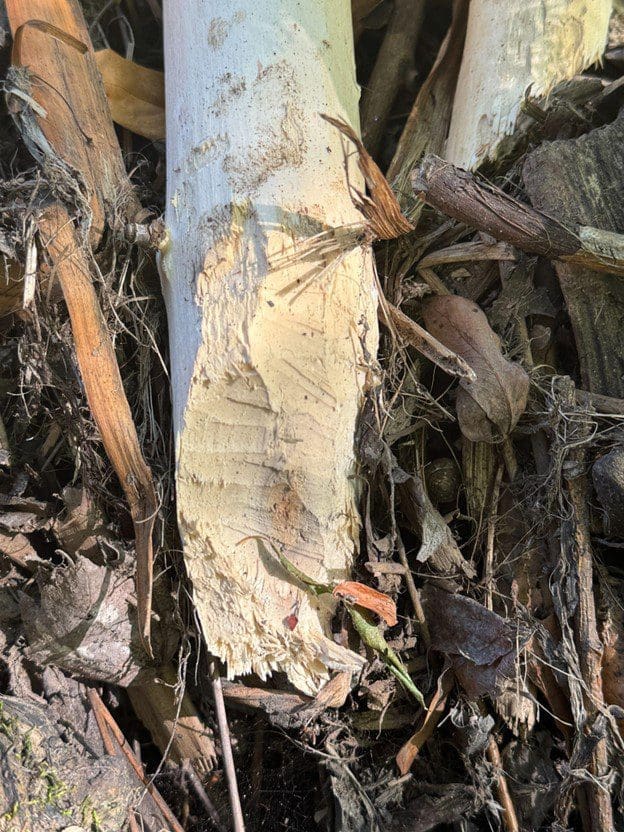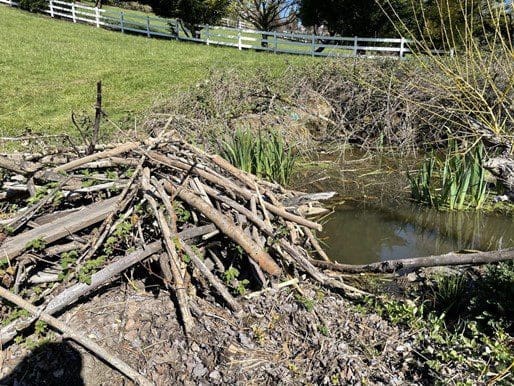Beaver lodge directly upstream of project area
Article submitted by Megan Hill, Education Specialist and Stephanie Wagner, OLWC Board Member
The North American beaver (Castor canadensis) is one of nature’s most powerful engineers—and a true hero when it comes to building healthy, resilient ecosystems. Once nearly wiped out by overhunting, beavers have made a remarkable comeback, bringing with them a wave of environmental benefits.
Beavers build dams, lodges, and other clever structures for safety, food access, and shelter. In doing so, they transform landscapes: slowing down streams, raising groundwater levels, and creating rich wetlands that support entire ecosystems. Their work helps:
- Create better habitat for birds, amphibians, and aquatic insects
- Filter out sediment and pollutants
- Provide cool, deep water for fish like salmon and trout
- Store water during droughts and release it slowly after storms
And they accomplish all this without machines, chemicals, or blueprints—just natural instinct and some serious teamwork.
Beavers live in close-knit family groups, usually made up of a breeding pair, their yearlings, and new kits. Young beavers stick around for about two years before heading off to start homes of their own. They’re devoted parents and build cozy lodges or dens with underwater entrances to stay safe from predators and the weather.
As herbivores, beavers have a diverse diet. They munch on tree bark and cambium from willows, alders, and cottonwoods, along with aquatic plants and roots. Though they’re famous for gnawing down trees, this behavior can actually promote plant diversity over time.
The wetlands beavers create act like giant natural sponges—soaking up stormwater and slowly releasing it during dry spells. They can even serve as firebreaks, helping to reduce the spread of wildfires. In a changing climate, the beaver’s role as a partner in resilience is more important than ever.
Sure, beavers can sometimes cause headaches—like flooding trails or chewing on backyard trees—but there are simple ways to live alongside them. Tools like flow devices can control water levels, and tree wraps can prevent unwanted nibbling. With a bit of creativity, communities can work with beavers—not against them—to restore habitat and manage water naturally.

Fresh beaver sign found July 2025
Restoring Beaver Habitat in Pecan Creek
OLWC is excited to be putting these concepts into practice through the new Pecan Creek Beaver Habitat Restoration Project, funded through an anonymous donor with the Oregon Community Foundation. Located near Stevens Meadow and the Urban Growth Boundary, this project will enhance riparian habitat and improve stormwater retention by removing invasive plants and replanting native species such as willow, alder, and cottonwood—key building materials and food sources for beavers.
Students from Lakeridge High School will play a central role, participating in field trips, ecological monitoring, and native plant propagation. A future goal of the project is to host public interpretive walks and community restoration events—offering more ways for people to connect with the power of beaver-led hydrology. This collaborative effort reflects OLWC’s mission to protect and restore watershed health while educating and empowering the next generation of stewards.
The Willamette Valley has lost an estimated 57% of its historical wetland habitat since European colonization—much of it due to development. Supporting beaver populations is one way we can reverse that trend.
A shout-out to OLWC Board member Stephanie Wagner for her contribution to the Axios article on Portland-area beaver restoration efforts.
To learn more about how beavers help fight wildfires, check out this National Geographic article.

